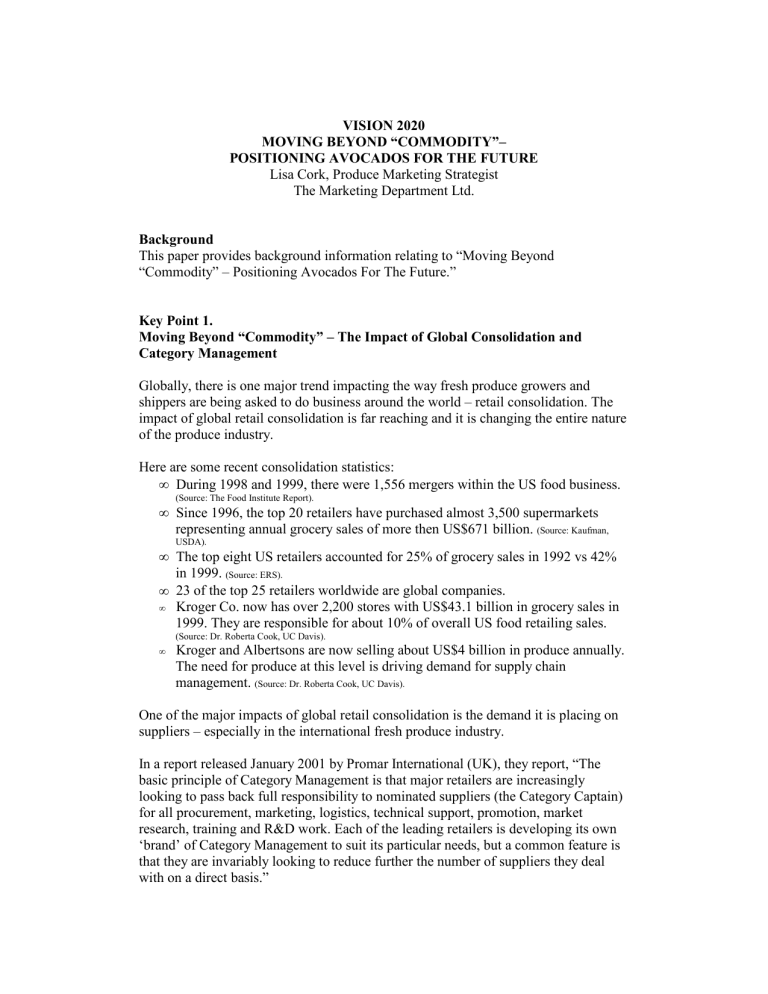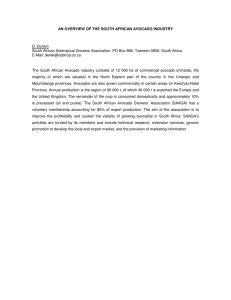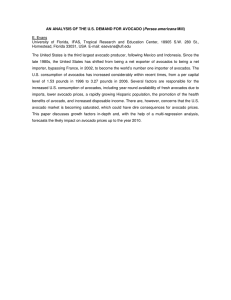Lisa Cork, Produce Marketing Strategist The Marketing Department Ltd.

VISION 2020
MOVING BEYOND “COMMODITY”–
POSITIONING AVOCADOS FOR THE FUTURE
Lisa Cork, Produce Marketing Strategist
The Marketing Department Ltd.
Background
This paper provides background information relating to “Moving Beyond
“Commodity” – Positioning Avocados For The Future.”
Key Point 1.
Moving Beyond “Commodity” – The Impact of Global Consolidation and
Category Management
Globally, there is one major trend impacting the way fresh produce growers and shippers are being asked to do business around the world – retail consolidation. The impact of global retail consolidation is far reaching and it is changing the entire nature of the produce industry.
Here are some recent consolidation statistics:
•
During 1998 and 1999, there were 1,556 mergers within the US food business.
(Source: The Food Institute Report).
•
Since 1996, the top 20 retailers have purchased almost 3,500 supermarkets representing annual grocery sales of more then US$671 billion.
(Source: Kaufman,
USDA).
•
The top eight US retailers accounted for 25% of grocery sales in 1992 vs 42% in 1999.
(Source: ERS).
•
23 of the top 25 retailers worldwide are global companies.
• Kroger Co. now has over 2,200 stores with US$43.1 billion in grocery sales in
1999. They are responsible for about 10% of overall US food retailing sales.
(Source: Dr. Roberta Cook, UC Davis).
• Kroger and Albertsons are now selling about US$4 billion in produce annually.
The need for produce at this level is driving demand for supply chain management.
(Source: Dr. Roberta Cook, UC Davis).
One of the major impacts of global retail consolidation is the demand it is placing on suppliers – especially in the international fresh produce industry.
In a report released January 2001 by Promar International (UK), they report, “The basic principle of Category Management is that major retailers are increasingly looking to pass back full responsibility to nominated suppliers (the Category Captain) for all procurement, marketing, logistics, technical support, promotion, market research, training and R&D work. Each of the leading retailers is developing its own
‘brand’ of Category Management to suit its particular needs, but a common feature is that they are invariably looking to reduce further the number of suppliers they deal with on a direct basis.”
From a grower’s perspective, what changes is Category Management bringing?
•
There are fewer buyers to go after.
•
There is downward pressure on prices.
•
There will be tighter relationships between growers, shippers and their customers.
•
There will be supply-side consolidation.
•
There will be more direct buying. In 1994, 36% of purchases were bought directly from growers/shippers. By 2004, this is expected to grow to over 50%.
•
Grower/shippers will be more involved in retail support and regional support.
Salespeople will have to be more service oriented and be supply chain specialists.
•
Grower/shippers will be expected to become solution providers through adding value and taking out costs from the supply chain.
•
Growers/shippers will be expected to create opportunities for unique premium products with enhanced flavour, appearance, nutrition and packaging.
•
Comprehensive food safety will be even more important.
•
Expect to see increased private labelling. Private labelling in Europe is enormous, with 46% share in the UK alone.
Relevance To Australia and New Zealand
While Australasia has remained mostly removed from consolidation fever, it is important to realise the drive towards Category Management is present in both countries. Retail buyers are looking for suppliers that are ‘programme focussed’ and add value to the distribution and retail channel.
While the impact of Category Management may seem daunting, growers/shippers who strive to understand the changes and requirements will thrive.
Key Point 2:
Moving Beyond “Commodity” – Nutritionally, Avocados Are A Winner
“Farm-Aceuticals” is the name The Packer recently gave fruits and vegetables because research is increasingly showing that plants contain vital disease fighting compounds called phytochemicals. Phytochemicals are naturally found, non-nutrient plant chemicals that contain protective, disease preventing compounds.
More than 900 different phytochemicals have been identified as components of fruits, vegetables and grains. To give an indication of how expansive phytochemicals are, it is estimated there may be more than 100 different phytochemicals in just one serving of vegetables.
Pharmacists cannot prescribe phytochemicals. In the United States, Americans spend approximately US$2 billion a year on vitamin/mineral supplements – soon to include phytochemical extracts. However, consumption of supplements containing phytochemicals will only provide selected components in a concentrated form – not the diversity of compounds that occur naturally in fresh fruits and vegetables.
So what do avocados contain? Here is some recent nutrition information from the
California Avocado Commission website.
Elizabeth Pivonka, Ph.D., R.D. President, Produce for Better Health Foundation states the following:
“When Americans reach for an avocado, they're getting more than they bargained for.
The avocado is loaded with phytonutrients, which are natural plant substances that work with nutrients and dietary fibre to help fight chronic illnesses, such as heart disease and cancer.
“These plant-based phytonutrients recently discovered in the avocado are betasitosterol and glutathoine. Beta-sitosterol helps lower blood cholesterol levels and is found in fruits like bananas, apples, strawberries and cherries. Ounce-per-ounce, avocados contain four times the beta-sitosterol found in oranges, which had previously been reported as the richest beta-sitosterol fruit source.
“Glutathoine, another phytonutrients found in fruits and vegetables, acts as an antioxidant. Antioxidants help the body by "mopping up" free radicals that are known to play a role in the development of heart disease and some cancers. Avocados, one of the best fruit sources of glutathoine, may offer some protection against oral, throat, and other types of cancer.
“Avocados, along with other fruits and vegetables, are nutrient-dense in vitamins E and C - other antioxidants that help promote healthy teeth and gums, and protect the body tissue from oxidative damage.
“Folate is another important nutrient that promotes healthy cell and tissue development. Consuming enough folate is essential for pregnant women and women of childbearing age. Avocados contain more folate per ounce than other fruits, so choose the fruit with the most "phyte" per bite!
“Potassium is a mineral that helps the body's fluids and other life-essential minerals stay in balance. The richest fruit sources of potassium are avocados and bananas. The power-packed avocado has only five grams of fat per serving (1/5 of an avocado) and the majority of the fat is monounsaturated; the same type of fat found in olive oil.
Studies have shown that monounsaturated fat may increase HDL (good) cholesterol, but has little effect on LDL (bad) cholesterol.
“Avocados are one of nature's whole foods - a natural for today's healthy lifestyle. So, give yourself a "phyting" chance and choose an avocado.”
Key Point 3:
Moving Beyond “Commodity” – Positioning Avocados For The Future
During the presentation, you will learn...
2. From production driven to market driven – a model for the future.
5. Grower / Association positioning strategies
6. Why information is power.
Notes:




